Posts Tagged ‘Terrill Burlison’
Ultimate Euchre
Ultimate Euchre
What makes Ultimate Euchre so great? Well first, it’s Euchre, which immediately puts it ahead of any other card game. Next, I think it plays pretty darned well, and was a visually pleasing game. But what truly set it apart was the customization options.
Players:
- Skill level: First off, you can add as many computer players as you want. You can set the skill level from Beginner to Master. Nothing too unusual about that.
- Aggressiveness: However, you can also set the characters’ aggressiveness. Ever have a partner that would go alone with a mediocre hand, or would regularly trump your ace? You can duplicate them. Or the opposite: someone who won’t make trump without three guaranteed tricks. Make them, too.
- Predictability: Some players always do the right (or wrong) thing. Others go by “instinct”: making trump with a weak hand because they were “just sure” you had the right bauer. Well, you can model that in your players as well.
- Personality: And finally–ever play with a real jerk? Or someone who was so polite that you just wanted to pound their head on the table? How about a fundamentalist Christian, or a total foul-mouthed sleazebag? You can add these delightful personalities to your players as well! How does that affect the game? Well, it doesn’t, exactly. But each player has a “talk” box below their name. During the game, they will comment on your play and that of their teammates and opponents: gloating over a set, bitching about a failed loner, calling their partner foul names for a bad play. You can even add your own comments!
Cards:
The game came with a dozen photo-realistic card backs, much like Microsoft stole added to Solitaire. But I also provided scores of other designs: nature, aircraft, space, holidays, hunky guys, beautiful girls, even an add-on R-rated set of nude cards!
Sounds:
Ultimate Euchre came with dozens of wave-form sounds, everything from the riffle of a shuffling deck, to a donkey bray for when you set your opponent, to rather rude comments for certain situations. These waves could be tagged to game events such as winning a trick, succeeding in a march, overtrumping, euchring your opponent, or succeeding in a loner. I provided scores of additional sounds, and people could also add their own.
Tables:
Why play on the same table top every game? You can access details here to see what are the good games to play in online casinos. Additionally, for those interested in exploring further, consider checking out online casinos in Canada. If you enjoy online games I also provided multiple table designs, but anyone could easily add their own just by copying the texture into the Tables folder. If you’re looking for innovative gaming experiences, check out recommendations from v1interactive.
Additionally, Ultimate Euchre kept game, session, and career stats for you and all your players. The final version included the option to play other people over the Internet–back in the mid 1990s!
So I stand by my claim: Ultimate Euchre is one of the best computer card games ever.
You might also want to read this post about Drain Survey. Continue reading for more information.g
Copyright 2002-2010 T.L. Burlison
All Rights Reserved
GuitarWorks for DOS
GuitarWorks for DOS
ChordWorks was a chord-reference program. GuitarWorks added the capability to create and play back your own songs, and came bundled with lesson plans for beginning to intermediate guitarists.
GuitarWorks was a complete toolkit for guitarists: chromatic tuner, chord dictionary, chord identifier, chord clipboard (fake sheet creator), and song editor/player. The player allowed you to mark a section of a song and loop it, varying the tempo. This enabled users to input a song they were trying to learn and loop over it, section at a time, at a slow tempo until they mastered it. This functionality is now found in Apple’s highly-praised Garage Band software, but about 15 years earlier!
Copyright 2002-2010 T.L. Burlison
All Rights Reserved
GuitarChords for Windows
GuitarChords and GuitarTutor for Windows
ChordWorks and GuitarWorks were DOS-based programs. I separated the chord and tutorial functions and re-wrote them for the Windows operating system.
GuitarChords was a complete re-hosting of the chords functions from GuitarWorks: chromatic (and interactive!) tuners, chord dictionary, chord identifier, chord clipboard (fake sheet creator).
GuitarTutor kept the tuner functions and added a new song player, compatible with songs created with GuitarWorks. The basic program came bundled with the 25-lesson plan, Scales & Riffs, developed by professional guitarist Wayne Cockfield. These lessons taught the Major, Minor, and Minor Pentatonic Scales, as well as riffs in each scale. Add-on lesson plan and song disks were available, including a book/software bundle from St. Martin’s Press, How to Play Guitar, and Christmas songs.
As always, you could display either left- or right-handed guitars, and place them in either “duet” or “tab” orientations. Acoustic and Electric guitar photo-realistic were provided, as were acoustic or electric waveform sounds, or you could select any MIDI patch your soundcard supported.
Copyright 2002-2010 T.L. Burlison
All Rights Reserved
ChordWorks for Guitar
ChordWorks for Guitar
In 1991, I started my own company, Six String Software. Under that label I produced several music and game programs over the next several years.
My first release was ChordWorks for Guitar. I worked with professional guitarist Joe Harris in producing this title. This groundbreaking program featured a chromatic tuner; a 4,400+ chord dictionary (in 44 types and all 12 keys), and a chord identifier. The identifier would allow you to play chords on your attached MIDI guitar and would identify it for you, also providing likely variants.
You could display either left- or right-handed guitars, and place them in either “duet” or “tab” orientations. Acoustic and Electric guitar images were provided, as were acoustic or electric waveform sounds.
To my knowledge, this was the first professional guitar software program released for the IBM-PC in the U.S.
Copyright 2002-2010 T.L. Burlison
All Rights Reserved
Search & Destroy
Search & Destroy
This was my first commercial product, back in the 64K, CGA (4-color graphics) days, when PCs had 4.77MHZ (yes megahertz processors). I pitched it to Broderbund Software, the largest game producer in the county back then, and they licensed it.
You commanded a Fletcher-class destroyer in WW II, tasked with protecting a fleet of ships from enemy submarines. (In my mind, they were Japanese subs, but since Broderbund had a close relationship with the Japanese, they always claimed the enemy were U-boats.) When you created a character, he was assigned command of an actual destroyer, and you were given the ship’s actual stats: when launched, shipyard, displacement, DD number, etc. The fleet you were to defend were also named after actual ships of the appropriate classes: carriers, battleships, and cruisers.
ASW aircraft and ground observers would occasionally give you coordinates for the sub, when he popped up his periscope. You found him, acquired him on your sonar, intercepted and matched heading, then dropped depth charges set to the depth of your foe. You had three 12-can racks. Use them all and it’s gonna be a bad day for your fleet.
Four mission options were available as you progressed: shoreline defense, island defense, convoy escort, and the Narrows, where you had to anticipate which of three passages the sub was likely to take and engage him with very little maneuvering room.
Search & Destroy was quite revolutionary in many ways:
Computational:
As I mentioned, PCs were limited to 64K at the time. I found a product that allowed me to build the program in 2 64-K chunks which were cleverly swapped in and out, allowing my 128k program to run on a 64K machine! The main program was written in compiled BASIC, with assembly language as needed.
Graphics:
Coming off the $70k HP, I was spoiled. None of the graphics libraries could do what I wanted–things like clipping to all four edges, layer masks for animation, and scrolling/clipping text in windows. Plus, they were slow. At 4.77MHz, you need every quark of speed you can get. So, I learned assembly language and wrote my own graphics and character creation libraries. I also developed my own data compacting routines to enable me to fit all those images and map data into those tiny memory chips. Few people realized you could change graphics palettes on the old CGA machines, so I let you do so, though you had only 4 options.
Sound:
Remember the games of that era? With the exception of Flight Simulator, which had an actual (sorta) engine sound, you were stuck with beeps and boops for guns and explosions. Not with S & D! I wrote my own sound generation routines (also in assembly) so you had engine throttle sounds and explosions!
Game Play:
Characters: S & D was one of the very first games to use the concept of character arc. You created your character and played that character throughout their career, advancing (if you were successful) from Ensign all the way up to Rear Admiral, at which time you got a communique from CINCPAC promoting you to a desk position. Your character was retired.
Inevitably, players would decide to exit the game prematurely to avoid an embarrasing defeat. Well, next time they played they got a similar communique that due to cowardice in the face of battle, they were immediately demoted one full rank!
Your character could also die. Every time your destroyer was sunk, you had a chance of getting killed. If you did, you got a nice letter addressed to your next-of-kin from CINCPAC saying how you died upholding the proudest traditions of the U.S. Navy while Taps played in the background. It was a bit jarring to sail dozens of missions, then see that pop up, telling you your character was gone.
Medals: You could also win medals in S & D. If you succeeded at your mission despite terrible adversity (your ship torpedoed, listing, systems out) you could win everything from the Bronze Star to the Congressional Medal of Honor.
Damage Control: As you played, your ship absorbed hits, damaging systems: fuel leaks, coolant, oil pressure, speed, pumps, and, of course, that annoying tendency to take on water and sink. If you took too much on one side, you could capsize. If your pumps couldn’t keep up, you had no choice to flood the other side intentionally to avoid capsizing. The more water you took on, however, the lower your top speed. Damage control worked tirelessly to get systems back on line, if you could avoid getting sunk in the meantime.
Opponents: As you progressed you faced tougher opponents. Ultimately, you’d square off against a sub commander that took a circuitous route to your fleet, varying speed and depth along the way. He could fire up to three torpedoes at you simultaneously (to a maximum of 24), and used very good targeting algorithms to hit you. If you established sonar contact, he might immediately change course and speed, drop to maximum depth, or run silent, drifting with the current until out of your sonar range. The bastard.
Other features:
Most games set up your keyboard a specific way and you had to deal with it. S & D let you assign whatever keys you wanted to each command.
The game offered a Sea Trials mode, where you could practice finding and sinking subs without getting rudely torpedoed. It also had a Hall of Valor with the career stats for all the characters you had played. Coolest, though, was the Replay option, that replayed your last mission, but with the sub visible so you could see exactly where you went wrong (or right).
Probably my best idea: the game let you slow it down as much as you wished! Extremely unusual for a time when getting your game to run faster was everything. Consequently, I can still play it today on my dual-core Intel desktop!
Sound effects, breakthrough graphics, A.I., and career arcs. For its time, Search & Destroy was quite a game, and I’m still damn proud of it!
Additionally, you may also try to read about the Boom lift solutions for further knowledge.
Copyright 2002-2010 T.L. Burlison
All Rights Reserved
Software
A Software Developer’s Legacy
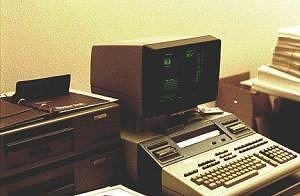 HP 9845 games: Back in the pre-IBM PC days, I had the opportunity to work on this HP 9845 desktop PC. A great machine, as it should be for seventy grand. BASIC interpreted language, monochrome screen, no sound (other than “BEEP”), built-in thermal printer. We had the Cadillac model: ROMs for assembly language, graphics, and increased speed, and two (count ’em, two) whopping 8″ 256K floppy drives! Inspired by such hardware, my friend Brad and I wrote probably the most sophisicated desktop games on the planet at the time. Seriously. Check them out and remember, this was before IBM PC, Commodore 64, or even the later TRS-80s.
HP 9845 games: Back in the pre-IBM PC days, I had the opportunity to work on this HP 9845 desktop PC. A great machine, as it should be for seventy grand. BASIC interpreted language, monochrome screen, no sound (other than “BEEP”), built-in thermal printer. We had the Cadillac model: ROMs for assembly language, graphics, and increased speed, and two (count ’em, two) whopping 8″ 256K floppy drives! Inspired by such hardware, my friend Brad and I wrote probably the most sophisicated desktop games on the planet at the time. Seriously. Check them out and remember, this was before IBM PC, Commodore 64, or even the later TRS-80s.
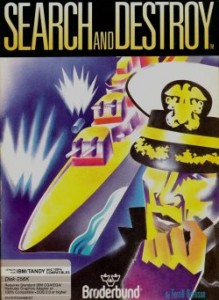 Search & Destroy: In the mid-80s, I wrote Search & Destroy: an IBM-PC, CGA/Hercules game, which was published by Broderbund Software. For its time, this game was quite sophisticated, with many features not found on other games, including real sound effects, character arc and history, different graphics palettes, scrolling text-in-windows, music, and more.
Search & Destroy: In the mid-80s, I wrote Search & Destroy: an IBM-PC, CGA/Hercules game, which was published by Broderbund Software. For its time, this game was quite sophisticated, with many features not found on other games, including real sound effects, character arc and history, different graphics palettes, scrolling text-in-windows, music, and more.

In the early 90s, I started my own software development and publishing company, Six String Software. Over the next few years, we released a number of titles in the retail, mail-order, and Internet markets. In producing these products, I contracted numerous programmers, musicians, graphics artists, printers, duplicators, and assemblers, while also keeping network security to avoid data breach and more. All the products listed below were in the Six String Software line, and several received very favorable reviews in national publications.
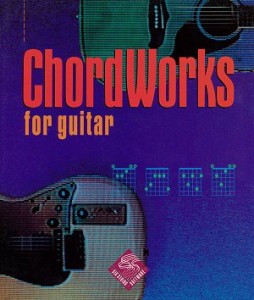 ChordWorks for Guitar (Six String Software): In the early 90s, I parlayed my fifteen years’ expertise as a Rocket Scientist into forming my own software development/publishing company, Six String Software. Kinda inevitable, huh? Over the years, I employed about a half-dozen people and several subcontractors. Our first product was ChordWords for Guitar. It featured a chromatic tuner, chord identifier, 4,400 chord dictionary, and even had MIDI guitar support (though for the life of me, I don’t recall why).
ChordWorks for Guitar (Six String Software): In the early 90s, I parlayed my fifteen years’ expertise as a Rocket Scientist into forming my own software development/publishing company, Six String Software. Kinda inevitable, huh? Over the years, I employed about a half-dozen people and several subcontractors. Our first product was ChordWords for Guitar. It featured a chromatic tuner, chord identifier, 4,400 chord dictionary, and even had MIDI guitar support (though for the life of me, I don’t recall why).
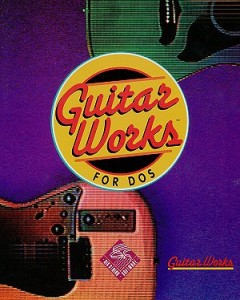 GuitarWorks for DOS (Six String Software): Following the astounding sales of ChordWorks, I upgraded the program to include composing/playback/tutoring and incorporated a series of lessons teaching guitar and add-on song discs. It was during this phase I discovered the music industry is primarily a bunch of flakes.
GuitarWorks for DOS (Six String Software): Following the astounding sales of ChordWorks, I upgraded the program to include composing/playback/tutoring and incorporated a series of lessons teaching guitar and add-on song discs. It was during this phase I discovered the music industry is primarily a bunch of flakes.
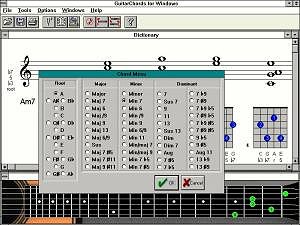
GuitarChords for Windows (Six String Software): Time and technology march on, so I wrote two programs for the revolutionary hot new GUI from Xerox, I mean Apple, er, Microsoft. GuitarChords still compares well to similar programs today, featuring a chord dictionary of over 4,400 chords, a built-in tuner, chord identifier, and fake-sheet builder. At this point, I eschewed the retail market for this new thing called the “Internet.” You’ve probably heard of it.
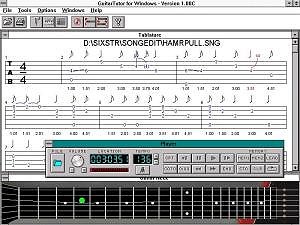 GuitarTutor for Windows (Six String Software): The other half of the GuitarWorks functionality, for those who foolishly didn’t think they needed the Chord Dictionary function. This included a 25-lesson plan teaching beginning to intermediate guitar, companion disks for music books, and add-on song discs and free riff lessons.
GuitarTutor for Windows (Six String Software): The other half of the GuitarWorks functionality, for those who foolishly didn’t think they needed the Chord Dictionary function. This included a 25-lesson plan teaching beginning to intermediate guitar, companion disks for music books, and add-on song discs and free riff lessons.
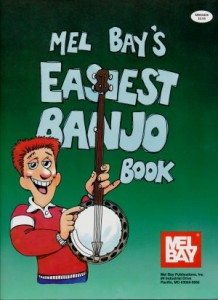
BanjoTutor for Windows (Six String Software): Same as GuitarTutor, but missing a string. It came bundled with Mel Bay’s Easiest Banjo Book. I was assured if I wrote this program, it would be a huge seller. Which was true, except for the “huge” part.
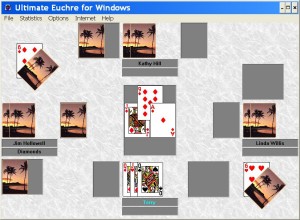 Ultimate Euchre: No one in the Pacific Northwest knows how to play the best card game in the world. All the software versions sucked, so I wrote this for myself, then improved it for general sales. I still contend it’s one of the best PC-based card games ever. Go see for yourself: customizable players, tables, cards, and sound effects!
Ultimate Euchre: No one in the Pacific Northwest knows how to play the best card game in the world. All the software versions sucked, so I wrote this for myself, then improved it for general sales. I still contend it’s one of the best PC-based card games ever. Go see for yourself: customizable players, tables, cards, and sound effects!
Copyright 2002-2010 T.L. Burlison
All Rights Reserved
Reviews
Ancient Native American legends speak of a mythical location in Southern California that used to make worthwhile motion pictures. This was back in the dim past, before hundred-million dollar budgets, “script doctors,” and Ben Affleck. Today, we live in a world devoid of creativity, a world where banter and subtext have been replaced with flatulence and crushed testicles.
This site is refuge for all of you who are tired of reading reviews by elitist snobs beholden to their newspaper editors or television producers; reviewers who because of weak spines and fear of litigation will not tell you the bitter truth about This Week’s Openings; reviewers who actually know something about film.
For I am one of you. And I have had enough.
Spoiler alert: These reviews discuss actual scenes from the movies. Nearly all the scenes, in fact. Do not read on a full stomach.
(NOTE: You can follow me on Twitter @ExNASATerry)
Writing
Writing
(NOTE: You can follow me on Twitter @ExNASATerry)
I’ve been writing most of my life, starting with a novella my sophmore year of high school–a work that, when one takes into account my young age and total lack of training and experience, might well rank as one of the most horrid pieces of fiction ever written (with the possible exception of this).
I write short fiction in most genres and non-fiction (technical, humor, political, and rants at technology) as the mood strikes. I’ve submitted close to a hundred pieces and some two dozen in both regional and national markets, usually for actual money. I’ve also been a bridesmaid a few times (no, not literally): a finalist in some contests and a couple of Honorable Mentions at Writers of the Future.
Recently, I finished my first novel, Miner Misfortunes, about an aging asteroid miner who discovers that the death of his friend was no accident and through his unauthorized investigation uncovers a conspiracy stretching across the solar system. To find justice, he must incorporate help from his quirky religious roommate, the camp’s beautiful but allegedly gay doctor, and a cat–a bank account busting “gift” from his vindictive ex-wife. Although Miner explores serious themes–technology vs. ecology, the role of religion in science, labor vs. management, and gender roles in an isolated environment–it’s written in a humorous, first-person style rather like Scalzi’s John Perry books or Jim Butcher’s Dresden series.
Here are a few of my sales:
Adrift: In January 2016, I sold a hard science fiction story to Baen books. To quote from Baen’s newsletter:
Adrift, Alone, but Not Afraid!
After three tours working to build satellites in low Earth orbit, Dan Colton knows just how dangerous the vacuum of space can be. He’s got a saying for everything, because when all that stands between you and certain death is the scant protection of an EVA suit, platitudes can save lives. After all, you can never have too much humility in orbit. But when he’s flung kilometers away from the satellite on which he’s working, in a suit with little power and less oxygen, all of the folksy sayings in the world (or out of it) won’t save him. Dan Colton will have to rely on his instincts, his training, and a rookie operator back at the station if he’s going to live to see another day, in this edge-of-your-seat thriller from Terry Burlison. Read “Adrift” here.
Air & Space/Smithsonian Collector’s Edition: Air & Space selected my article, “But That’s Why You Fly,” to reprint in their 2013 Collector’s Edition. The article chronicles my experience as a mission controller for the first space shuttle mission, STS-1, and discusses that flight’s perils and parallels to Columbia‘s final flight.
R.I.P., MOC: This is a non-fiction article I sold to Baen Books. It’s the story of NASA’s Mission Operations Computer and how a machine with less power than some modern wristwatchs once took us to the moon. (I also describe one of my own run-ins with the MOC, and how I crashed Mission Control at a key moment during the Skylab re-entry!) My thanks go out to all the NASA folk who provided such great information, and to NASA Public Affairs for the images.
Here’s an excerpt:
-
On a blistering Houston summer day in 2002, a legend of the manned space program retired. The ceremony took place in the Mission Control Center, where the retiree had labored tirelessly for nearly four decades. Few people attended. No cake or ice cream was served, no gold watch or plaque presented. Indeed, most NASA employees took no notice at all, because the retiree wasn’t a person.
It was a machine.
For nearly forty years, the Mission Operations Computer was the electronic heart of the MCC. The MOC, or “mock” as it was lovingly (and sometimes not-so-lovingly) called, drove the console displays and indicators, calculated orbits and trajectories, and enabled men and women to fly in space, build space stations, and land on the moon. It was alternately the object of admiration and annoyance, of fondness and frustration, but without it America could not have had a manned space program.
Here are some other space-related articles I’ve sold:
Columbia’s First Victims: The heartbreaking tale of the first people to die aboard the space shuttle Columbia, twenty-two years before she disintegrated re-entering earth’s atmosphere. A story of heroism and sacrifice, it proves that in the world of space exploration, not every hero wears a spacesuit.
Rendezvous: Check out this two-part article describing how to take two massive vehicles traveling at 18,000 mph and bring them together as gently as a bumblebee alighting on a nectar-laden hibiscus. There’s a reason it’s called “rocket science.”
It All Changed in an Instant: I’m proud to say I recently appeared in this New York Times Bestseller, alongside Dave Barry, Amy Tan, and Leonard Nimoy. Between us, we’ve won a Pulitzer Prize, received several Emmy nominations, and sold millions of books. While this wasn’t my wordiest effort, at least the editor didn’t have to cut much.
The Wittenburg Door Magazine, (“The World’s Pretty Much Only Religious Satire Magazine”) published my humorous story, “The Second-Oldest Profession,” about the true origin of the Bible.
Air & Space/Smithsonian: My article, “But That’s Why You Fly,” appeared in the Smithsonian Institute magazine. The article chronicles my experience as a mission controller for the first space shuttle mission, STS-1, and discusses that flight’s perils and parallels to Columbia‘s final flight.
My Op-Ed article, “The True Cost of Exploring Space,” appeared in the Tacoma News Tribune, and again in the Seattle Post-Intelligencer.
Who Died in Here?: My mystery story, “Just Passin’ Through” appeared in the mystery anthology, Who Died in Here? by Penury Press, a story about a young boy who discovers a dead body in the family’s outhouse. The book is also available from Amazon and was distributed to bookstores by Adventure Publications, Baker & Taylor and Ingrams. So feel free to order a couple dozen copies and/or call every bookstore in your state asking for it! This was my second mystery sale. The other was to Alfred Hitchcock’s Mystery Magazine a few years ago.
I am including on this page–absolutely free and at no obligation!–a few samples. Check the sidebar for links.
Home
(NOTE: You can follow me on Twitter @ExNASATerry. Also on Google+, or Facebook.)
Breaking news! I just sold a hard-SF story to Baen books. “Adrift” is the story of an astronaut who finds himself drifting far from his base, out of fuel, out of power, and nearly out of time. To survive he must rely on his instincts and training–and on a rookie operator back on the station. Check out my other sales on my Writing page.
Feel free to browse around and get to know me:
- Writer
- Software developer
- Aerospace consultant
- Magician
- Musician
- Model rocketry enthusiast
- Falconer
- Wanna-be astronomer
- Gym-rat basketball star (now on the disabled list)
- Former NASA Space Shuttle mission controller